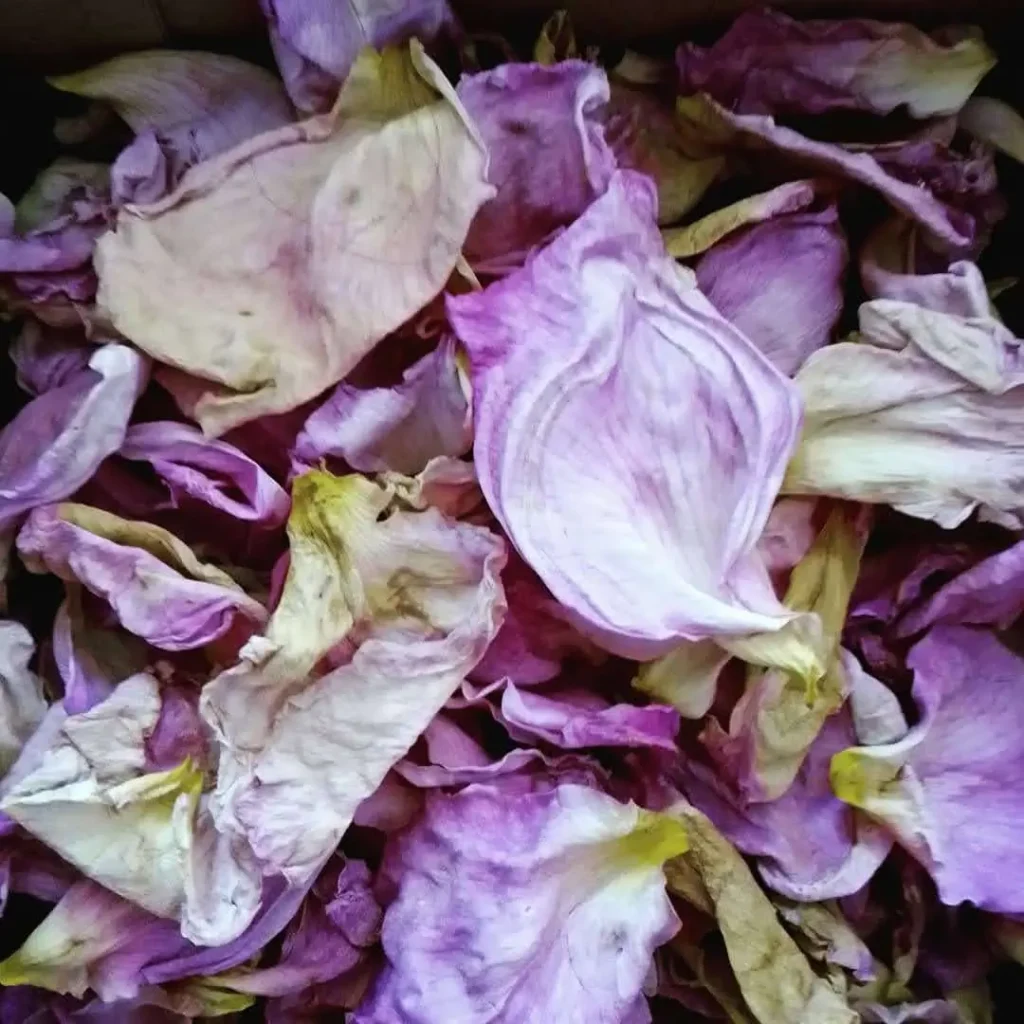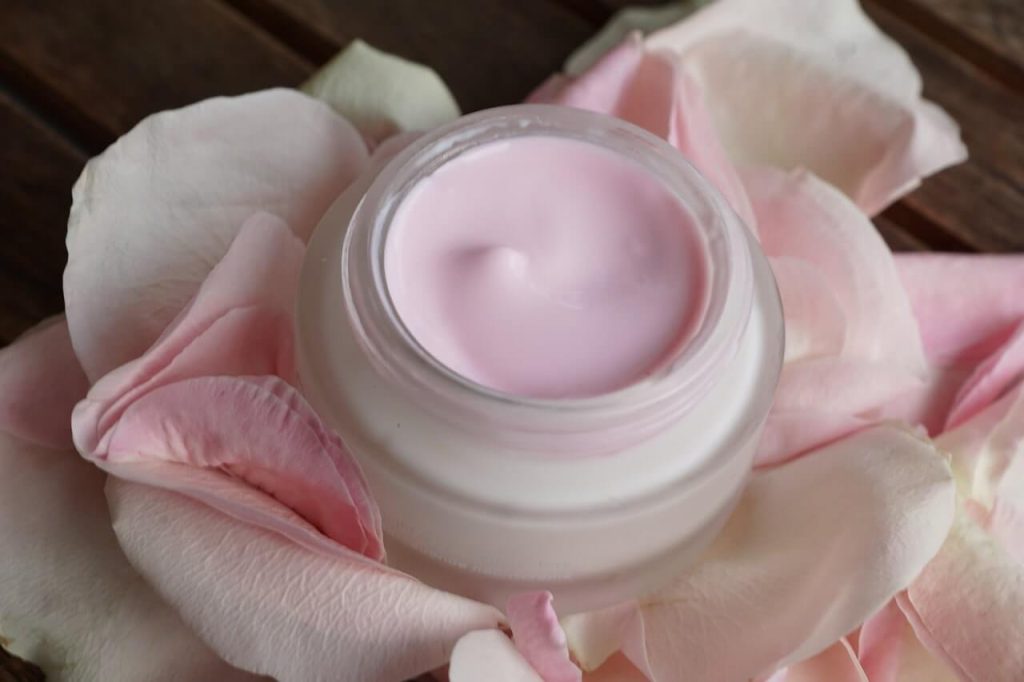Introduction to Rose in Natural Skincare
There’s something timeless about roses. Whether it’s the velvet softness of their petals, the way they catch sunlight in early morning dew, or their delicate scent that makes you pause mid-step — roses have been winning hearts (and skin) for centuries.
In skincare, the rosa damascena (Damask rose) and rosa centifolia (French or cabbage rose) are especially loved, not just for their beauty, but for their numerous benefits. They’re rich in vitamins A and C, antioxidants, and essential fatty acids that help strengthen the skin barrier, neutralize free radicals, and keep dry skin feeling soft and plump.
From ancient traditional medicine to modern organic cosmetics, rose extracts and rose oils have been used to soothe skin inflammation, treat acne, and even support collagen production for anti-aging benefits. You’ll find them in everything from natural toners and face creams to rose hip seed oil serums and lip balms.
In this full plant profile, we’ll explore the rose from petal to hip:
- what makes it such a remarkable skincare ingredient,
- how to extract its active goodness at home, and
- the best ways to add it to your beauty routine for glowing, healthy skin.
Whether you’re dealing with sensitive skin, hoping to brighten the complexion, or simply love the hydrating power of roses, this flower has something for everyone.

Botanical Background & Plant Characteristics
When we talk about rose in skincare, we’re really talking about a whole family of beauty powerhouses. The genus Rosa includes more than 300 species of rose, but a few stand out for their skin-loving qualities — especially rosa damascena (Damask rose), rosa centifolia (French rose or cabbage rose), rosa gallica, and the wild-growing rosa canina (rose hips).
Rosa damascena is famous for its intoxicating scent and high levels of antioxidants, while rosa centifolia is softer, with a delicate aroma and excellent astringent properties. Rose hips, on the other hand, come from parts of the rose that appear after the petals have fallen — and they’re a concentrated source of vitamin C content, essential fatty acids, and skin-nourishing nutrients.
Most rose plants are perennial shrubs with thorny stems, fragrant rose flowers, and lush blooms in shades ranging from blush pink to deep crimson. The petals and rose scent are derived from volatile compounds that make their way into rose extracts, hydrosols, and oils — all prized in natural skincare.
Roses grow best in sunny spots with well-drained soil, and their seasonal availability peaks in late spring and summer. Traditional harvesting is done early in the morning, when the parts of the rose are richest in aromatic compounds. This is when petals are hand-picked for rose essential oil distillation, ensuring that the skincare benefits remain intact.
Plant Energetics for Skincare
Roses bring a gentle, cooling energy to the skin — the kind that instantly calms redness and irritation after a long day or too much sun exposure. This makes them a natural choice for sensitive skin, acne-prone skin, or anyone whose skin needs a little help to recover from UV radiation or environmental stress.
Their moisturizing properties help balance the hydration of the skin, strengthening the moisture barrier and supporting the skin’s natural repair process. Think of rose as the friend who quietly refills your glass of water before you even realize you’re thirsty — except here, it’s your skin soaking up the benefits.
On an emotional level, the aroma of rosa damascena and rosa centifolia is known to relieve stress, lift the mood, and create a feeling of comfort. In herbal energetics, rose is often used to soothe both the skin and the heart — ideal for self-care rituals that go beyond the surface.
Best uses by season or skin condition:
- Summer & hot climates: Rose hydrosol or facial mists to cool and refresh.
- Winter & dry skin: Rose oils and rose hip seed oil to lock in moisture and protect from skin damage caused by harsh winds.
- Oily or acne-prone skin: Light natural toner with rose water to help control excess oil production while calming inflammation.
- Mature skin: Rose extracts to support collagen production, soften the appearance of wrinkles, and prevent premature aging.
Synergy: Roses pair beautifully with chamomile for extra soothing, lavender for anti-inflammatory and antibacterial properties, and frankincense for deeper anti-aging benefits. Learn more about how cooling herbs like rose work in skincare through our complete guide to herbal energetics.
Sustainability & Ethical Harvesting
Not all roses are grown — or harvested — the same way. If you want the full skincare benefits of roses while staying true to eco-friendly values, it’s worth knowing where your petals come from.
Wild vs. cultivated:
Wild rosa canina and rosa rugosa (often called Japanese rose) can be found in hedgerows and along coastlines, but in some regions they’re considered invasive. If you forage, make sure you’re not damaging local ecosystems. Most high-quality rose extracts and rose oils for skincare come from cultivated damask roses (rosa damascena) and french roses (rosa centifolia), often grown organically in Bulgaria, Morocco, and Turkey.
Ethical sourcing:
Look for suppliers who:
- Hand-pick petals early in the morning for peak aromatic and antioxidant content.
- Avoid harmful pesticides that could affect both your skin and the planet.
- Support local farming communities.
Home growing tips:
If you’ve got the space, growing your own rose plants can be deeply rewarding. Choose organic cosmetics-friendly varieties like cabbage rose or damask rose, avoid chemical fertilizers, and harvest parts of the rose (petals or hips) when fully ripe but before they fade. Early morning harvest preserves the levels of antioxidants and the delicate fragrance.
By choosing roses that are grown with care — whether from your own garden or a trusted source — you’re not just protecting your skin from oxidative stress and skin damage, you’re helping protect pollinators and the planet, too.
If you’d like to explore more ways to align your skincare with eco-conscious choices, take a look at my sustainable beauty practices guide.
Active Compounds & Their Cosmetic Effects
Roses aren’t just pretty — they’re tiny biochemical treasure chests packed with skin-loving compounds. The most famous is their vitamin C content, especially concentrated in rose hips (rosa canina). Vitamin C helps neutralize free radicals, support collagen production, and protect against premature aging caused by sun exposure and UV radiation.
Alongside vitamin C, rose hip seed oil and other rose extracts are rich in essential fatty acids (omega-3 and omega-6). These strengthen the skin barrier, improve elasticity, and help the skin hold onto moisture — a must for dry skin and mature skin.
Flavonoids and phenolic acids give rose its powerful anti-inflammatory properties, helping to calm redness and irritation, soothe skin inflammation, and even support wound healing. Some of these compounds also have antibacterial properties, which is why rose water and rose oil can help treat acne and control excess oil production without over-drying the skin.
Rose petals also contain tannins, which offer gentle astringent properties — tightening pores and toning the skin — making them ideal for use in natural toner formulations.
Solubility matters:
- Oil-soluble compounds (like essential fatty acids and some antioxidants) are best captured in rose oils or oil macerates.
- Water-soluble compounds (like vitamin C and tannins) shine in rose water, glycerites, and tea infusions.
Fun fact: The exact levels of antioxidants and vitamins can vary depending on the species of rose, whether the petals are fresh or dried, and even the time of day they’re harvested. Morning-harvested petals tend to yield the richest aroma and bioactive compounds.

Skincare Benefits of Rose
Roses don’t just look soothing — they actually are soothing on a cellular level.
According to a 2018 PubMed study, rose petal extract (RPE) reduced UV-induced skin inflammation by lowering COX-2 levels and calming cytokine activity — two key factors behind redness and irritation after sun exposure (source).
Researchers also found that rosa damascena petals are naturally rich in antioxidants like anthocyanins, polyphenols, and flavonoids. These compounds help neutralize free radicals, reduce oxidative stress, and protect the skin barrier from premature aging.
In practical terms, using rose in your skincare routine can:
- Calm soothing skin inflammation and sensitivity.
- Protect against sun damage and environmental stressors.
- Support collagen production for smoother, firmer skin.
- Help treat acne thanks to its anti-inflammatory and antibacterial properties.
Whether you choose a light natural toner with rose water, a nourishing rose hip seed oil serum, or a cream enriched with rose extracts, you’re giving your skin more than a pleasant scent — you’re giving it active, science-backed protection with numerous benefits for both dry skin and acne-prone skin.
DIY Herbal Extracts You Can Make
One of the best things about rose as a skincare ingredient is how easy it is to transform those petals and rose hips into potent, skin-loving extracts right in your own kitchen. Each method captures different compounds — so you can choose based on the skin benefits you’re after.
1. Rose Oil Macerate
Perfect for dry skin, mature skin, or anyone looking to protect the moisture barrier.
- Solvent: Carrier oil (like jojoba or sweet almond) — draws out oil-soluble compounds such as essential fatty acids and some antioxidants.
- Extraction time: 2–4 weeks in a sunny windowsill, shaking occasionally.
- Shelf life: 6–12 months in a dark glass bottle.
- Uses: Facial oils, lip balms, face creams, or body oils.
- 📎 Learn more: You can find full instructions for making a rose oil macerate in my detailed herbal oil infusion guide.
2. Rose Glycerite
A gentle, alcohol-free extract for sensitive skin and acne-prone skin.
- Solvent: Vegetable glycerin — extracts water-soluble compounds while keeping it shelf-stable.
- Extraction time: 4 weeks.
- Shelf life: 1 year if stored in a cool, dark place.
- Uses: Serums, mists, toners, and organic cosmetics for kids.
If you’ve never made a glycerite before, my step-by-step glycerite guide walks you through the process so you can easily create your own rose extract at home.
3. Rose Tea or Decoction (for topical use)
Ideal for natural toner or compresses to soothe skin inflammation.
- Solvent: Hot water — draws out vitamin C content, tannins, and flavonoids.
- Preparation: Steep fresh or dried petals for 10–15 minutes. Cool before use.
- Shelf life: Use within 24 hours or store in the fridge for up to 3 days.
4. Rose Tincture
A concentrated extract for more advanced DIY formulations.
- Solvent: Alcohol — pulls out both antioxidants and some volatile oils.
- Extraction time: 4–6 weeks.
- Shelf life: 2–3 years.
- Uses: Add small amounts to water-based serums, toners, or creams for an antioxidant boost.
💡 Pro tip: You can mix and match — for example, combine a rose oil macerate with a rose glycerite in a cream to capture both oil- and water-soluble actives for maximum hydrating power and anti-aging benefits.
Store-Bought Extracts & Their Use in Formulation
If you’re not in the mood to make your own extracts, you can still enjoy the numerous benefits of rose through high-quality, ready-to-use ingredients. Here’s what to look for:
Rose Hydrosol
- What it is: The aromatic water left after distilling rosa damascena or rosa centifolia for essential oil.
- Skin benefits: Cooling, soothing skin inflammation, balancing ph balance, and refreshing dry skin or sensitive skin.
- How to use: As a natural toner, facial mist, or in water-based skincare formulations.
- Solubility: Water-soluble — add directly to toners, gels, and creams.
Rose Essential Oil
- What it is: Potent, aromatic oil derived from rose petals, often from damask roses.
- Skin benefits: High in antioxidants, supports collagen production, helps reduce redness and irritation, and offers anti-aging properties.
- How to use: Always dilute before applying to skin — 0.5% or less in facial products. Ideal for facial oils, serums, and face creams.
- Solubility: Oil-soluble — blend into oils, balms, and emulsions.
💡 Fun Fact: It takes around 5–7 kg of fresh rose petals — that’s roughly 15,000 to 20,000 blooms — to produce just 10 ml of pure rose essential oil. No wonder this oil is considered one of the most precious (and expensive) in the world.
CO₂ Rose Extract
- What it is: A concentrated, solvent-free extract capturing both volatile and fixed oils from rose flowers.
- Skin benefits: Combines the hydrating power of rose oil with the antioxidant boost of polyphenols — great for mature skin and premature aging concerns.
- How to use: Low dosage (0.1–0.5%) in serums, anti-aging creams, and balms.
- Solubility: Oil-soluble — works best in oils and emulsions.
💡 Pro tip: If you purchase rose ingredients, choose reputable suppliers who focus on ethical sourcing and organic cosmetics. Not only will you get better quality for your skin routine, but you’ll also avoid unnecessary additives that can irritate sensitive skin.

How to Use Rose in Natural Skincare
Roses are one of those rare skincare ingredients that can work their magic in almost any product — from the simplest natural toner to the richest face creams. The trick is knowing which form of rose works best for your skin goals.
Facial Oils & Serums
- Use rose oil macerate or rose hip seed oil to deeply nourish dry skin, boost collagen production, and soften the appearance of wrinkles.
- For acne-prone skin, add a tiny amount of rose essential oil (diluted) to help control excess oil production while calming redness.
Creams & Lotions
- Add rose extracts or CO₂ rose extract for anti-aging benefits, antioxidant protection, and moisturizing properties.
- Pair with hyaluronic acid for extra hydrating power and a plump, fresh look.
Balms
- Combine rose oil with shea butter for a multi-purpose balm that soothes skin damage from wind, cold, or sun exposure.
Mists & Toners
- Spray rose hydrosol as a quick skin refresher that helps balance ph balance and tighten pores. Perfect for mid-day pick-me-ups or after a workout.
Hair & Scalp Care
- Add rose water to shampoos for a gentle scent and scalp-soothing effect — especially nice for dry or irritated scalps.
Synergy with Other Herbs
- Combine with chamomile for extra calming, lavender for anti-inflammatory and antibacterial properties, or calendula for faster wound healing and improved skin barrier health.
📎 If you’re ready to try it, check out my DIY Rose Facial Oil Recipe and Rose Hydrosol Toner Guide (internal links).
Safety & Contraindications
While roses are generally gentle and well-tolerated, it’s still important to keep a few things in mind — especially if you’re using concentrated forms like rose essential oil or CO₂ rose extract.
Pregnancy & Breastfeeding
- Rose hydrosol and rose hip seed oil are usually safe for topical use, but high concentrations of essential oil and rose should be avoided unless approved by a qualified aromatherapist.
Allergies
- Although rare, some people may react to compounds in rose extracts or rose oils. If you have a history of plant allergies, patch test first.
Usage Concentrations
- Rose essential oil: For facial products, stick to 0.5% or less. For essential oils in general, always check the MSDS (Material Safety Data Sheet) and confirm the IFRA dermal limit before formulating.
- CO₂ rose extract: Use at 0.1–0.5%.
- Rose hip seed oil: Can be used at 100% strength but blends well with other carrier oils.
Interactions & Skin Conditions
- For acne-prone skin, avoid heavy, occlusive formulations with rose oil if they tend to clog your pores. Instead, use lighter emulsions or hydrosols.
- If you have sensitive skin or rosacea, start with rose water or rose hydrosol before trying concentrated extracts.
Internal Use Disclaimer
- This profile focuses on topical skincare. Internal use (like rose tea for sore throats or other medicinal purposes) should only be done under guidance from a qualified herbalist.
💡 Pro tip: Even gentle plants like rose can cause irritation in certain situations — especially after sun exposure or if combined with harsh exfoliants. Listen to your skin and adjust your skincare routine accordingly.
Final Thoughts & Reader Invitation
Roses are more than just one of the world’s favorite flowers — they’re a bridge between beauty and skin health. From the gentle hydrating power of rose hip seed oil to the refreshing coolness of rose hydrosol, every part of this plant offers a way to nurture your skin and your senses.
Personally, I keep coming back to rose because it does something few other botanicals manage: it makes skincare feel like self-care. There’s a quiet ritual in misting your face with rosa damascena water on a hot afternoon, or massaging in a few drops of rose oil before bed. It’s more than hydration — it’s a pause, a breath, and a little reminder to be gentle with yourself.
If you haven’t tried rose in your skincare routine yet, start small: maybe a simple DIY rose facial oil or a homemade rose water toner. See how your skin responds, and notice how the scent makes you feel.
I’d love to hear from you — have you ever used rose skincare? Did you make your own or find a store-bought favorite? Share your experience (and your best rose tips) in the comments below.
See you in the next post, where I’ll show you how to pair rose with another flower for an antioxidant powerhouse blend. 🌿
Kristina
